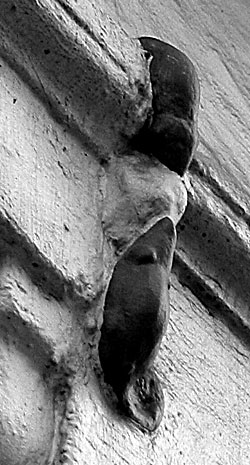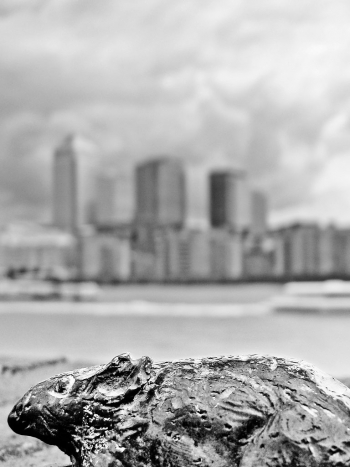A couple of years ago, for reasons that are far too complex to go into here, I was wandering around Woolwich Market wearing a heart monitor. Whilst browsing the stalls and admiring passing dogs, I suddenly noticed a dog that didn’t really look like a dog. That’s because it wasn’t. It was a ferret. I forgot to look down at the monitor to check my heart rate, but I have a feeling that it leapt quite dramatically. I’ve always had a soft spot for ferrets. I like them for the same reason that I like dachshunds: animals with long tubular bodies are intrinsically funny.
The ferret was being walked on a lead by an amiable man who was happy to share his enthusiasm for the animals. He pulled out another ferret from the pouch in his jumper and proclaimed proudly “I’ve got thirty of ’em at home!” I asked whether the ferret’s reputation for viciousness was justified. “Nah – they’re docile,” he replied, and proved this by bending and twisting the ferret into strange shapes. It was as if he was trying to create a balloon animal. “Flexible backbones, y’see. Allows ’em to go down holes.” The ferret was entirely unconcerned about the fevered manipulation its body was receiving; it merely blinked now and then. The sight of a ferret being manipulated would, in itself, have been enough excitement for me, but then the owner’s young daughter insisted on showing me her party piece. She opened her mouth and the ferret put its head in, a modest variation of the head-in-lion’s-mouth circus trick.
This got me thinking. How often do you see ferrets in London? Not often, although I have seen several over the years. I’ve spied a ferret waiting for a train at New Cross station (in the company of a responsible adult, I hasten to add) and another being walked in Greenwich Park. But if ferrets are rare, then their wild relatives are more numerous. Rats are the most prolific of all London’s wildlife, and anyone who lives in an old house has stories about the menace of mice. A friend of mine once even had a mouse living in his glockenspiel. The mouse slipped in and out by nosing a note to one side. We agreed that the only word that could be used to describe this mouse was ‘audacious’.
Throughout the centuries, rodents and humans have lived alongside each other, sharing an intimate and uneasy relationship. London’s bubonic plague epidemics of 1349 and 1665 were caused by germ-carrying fleas which lived as parasites on rats. Attempts were made to rid houses of rats, although some methods were more esoteric than others. In the Middle Ages, it was believed that if a cat and a rat were built into a house wall they would keep away rats. The logic being employed here seems somewhat obtuse to say the least: surely a living cat would be more effective for keeping the rodent population down? Regardless of this, the practice survived for centuries; a mummified cat and rat were found in the wall of an eighteenth-century house recently demolished in Bloomsbury.
When London’s sewer system was built in the nineteenth century, many rats decided that they would be better off underground. Lurid stories were told about so-called “water rats” which, according to a sewer worker interviewed by Victorian sociologist Henry Mayhew, were “far more ferociouser than any other rats”. Another worker related a chilling tale which demonstrated the danger posed by these fearsome beasts. “They’re some of ’em as big as good-sized kittens. One of our men caught hold of one the other day by the tail, and he found it trying to release itself, and the tail slipping through his fingers; so he put up his left hand to stop it, and the rat caught hold of his finger, and the man’s got an arm now as big as his thigh.”
But London has also been home to more distinguished rodents. The Wombles who lived on Wimbledon Common were certainly rodents, although no one really knows which kind; perhaps they were a rodent amalgam, a sort of Everymouse. Roland Rat, of Good Morning Britain fame, was either born in a sewer underneath King’s Cross or created by Greg Dyke, depending on how tenuous your grip on reality is. Danger Mouse, the dynamic crime-fighting white mouse, had his headquarters inside a Mayfair pillar box. His second-in-command, Penfold, was a little besuited hamster with eyebrows which hovered perpetually just above his head. Cynics might well point out that none of the above rodents actually exist, to which I reply: how does the cold, hard certitude of science grip you? The Science Museum houses two of the first genetically engineered mice, freeze-dried and donated by Harvard Medical School in 1989.
 Two monuments commemorate the rodents of London for posterity. A nineteenth-century building in Philpot Lane bears a carving of two mice nibbling a tiny portion of cheese. Tradition says that the builders set them into the front to commemorate the mice that plagued them throughout their task. Although the building is now home to a restaurant and coffee shop, the owners are clearly proud of their longest-surviving residents: the mice have been painted a glossy brown and their little wedge of cheese a bright yellow. Further south, on a quiet stretch of the Thames Path near Rotherhithe, another rodent is easily overlooked. A menagerie of bronze animals ambles towards Surrey Docks Farm: there’s a family of pigs snuffling the ground, a fox prowling behind some waddling geese, and a couple of goats gazing blankly ahead, as goats always do. But, over on the Thames wall, there’s an odd little raised bump. On closer inspection, it becomes apparent that it’s not even big enough for a bump; it’s more of a blip. It’s a perfectly modelled bronze mouse.
Two monuments commemorate the rodents of London for posterity. A nineteenth-century building in Philpot Lane bears a carving of two mice nibbling a tiny portion of cheese. Tradition says that the builders set them into the front to commemorate the mice that plagued them throughout their task. Although the building is now home to a restaurant and coffee shop, the owners are clearly proud of their longest-surviving residents: the mice have been painted a glossy brown and their little wedge of cheese a bright yellow. Further south, on a quiet stretch of the Thames Path near Rotherhithe, another rodent is easily overlooked. A menagerie of bronze animals ambles towards Surrey Docks Farm: there’s a family of pigs snuffling the ground, a fox prowling behind some waddling geese, and a couple of goats gazing blankly ahead, as goats always do. But, over on the Thames wall, there’s an odd little raised bump. On closer inspection, it becomes apparent that it’s not even big enough for a bump; it’s more of a blip. It’s a perfectly modelled bronze mouse.
The historical fabric of London is nibbled through by rodents. For better or worse, they have as much right to be here as us. We leave crumbs on the kitchen floor; mice munch them. We drop litter in the street; the rat population gnaws an existence from it. All rodents are in a sense Wombles, making use of the things that the everyday folks leave behind. We take what we want from London and, to a much more modest degree, so too do its many rodents.


